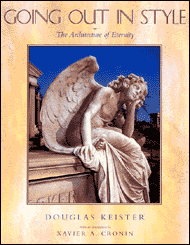
|
|
|
|
|
Submit email feedback on this item:
|

|
|
Filename :
|
GC100.JPG |
|
Description :
|
Wieting Mausoleum
Oakwood Cemetery
Syracuse, New York
The jury is still out on what the architect/builder was thinking when designing the Wieting Mausoleum in 1880. Some say it resembles of an East Indian, Tibetan or Chinese Stupa. Stupas were most frequently associated with the Buddhist culture in these countries. The conical shape of Stupas reflect the Buddhist belief that one proceeds in an ascending process towards unification. Indeed, in China, Stupas are often used to surmount tombstones and burial chambers.
Dr. John M. Wieting, (1817-1888) a medical doctor, made his fortune in real estate, but achieved fame as a lecturer. He discoursed on physiology and hygiene, using something known as the “apparatus” (apparently a contraption using a mannikin with removable parts) all over the world. He was frequently compared to Mark Twain in his ability to hold an audience’s attention.
Wieting also had a great love for the arts. He built the Wieting Opera House in Syracuse, which he and his descendents have rebuilt four times (1851, 1856, 1881 and 1897) following disastrous fires.
In 1878 Dr. Wieting and his wife embarked on a world tour, traveling to Japan, Singapore, Ceylon, India and Egypt. It is likely that these travels influenced the design of the mausoleum, built soon after he returned from the Orient. |
|

